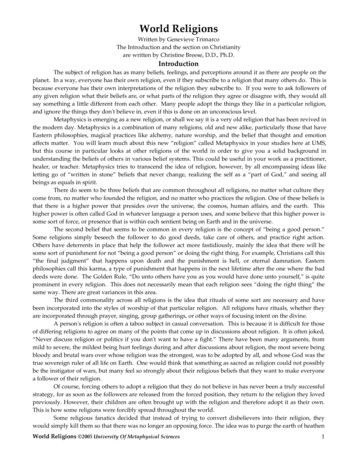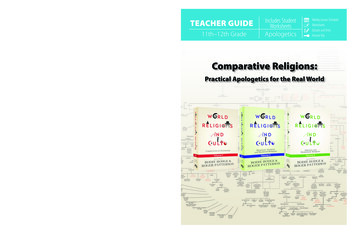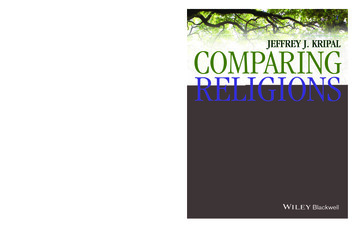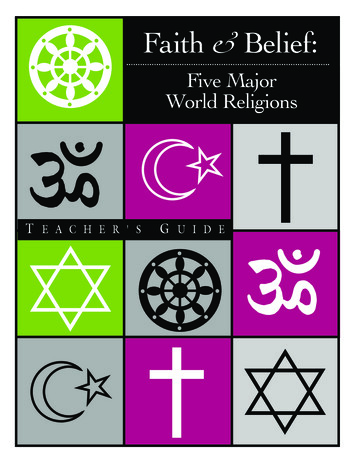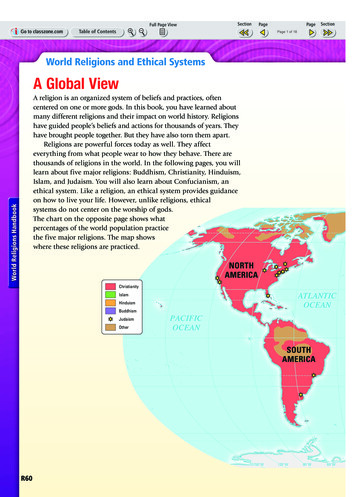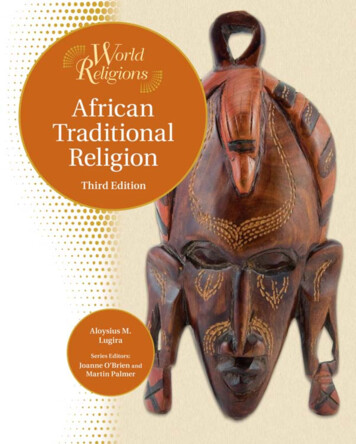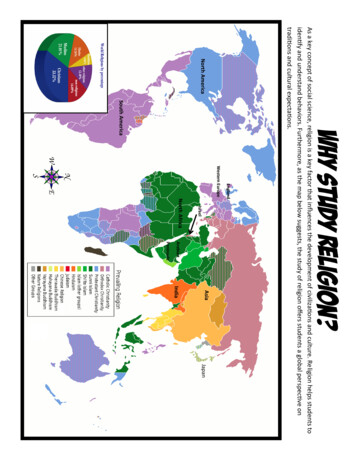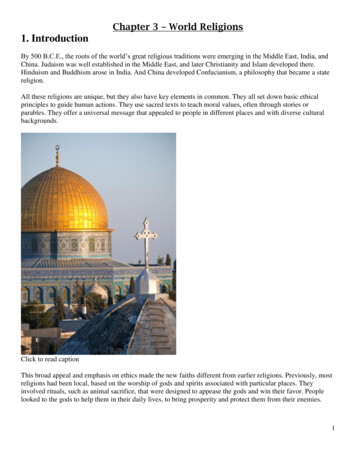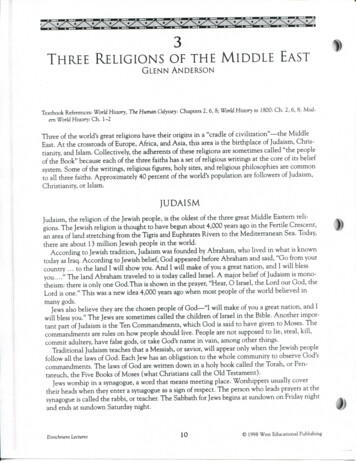
Transcription
3THREE RELIGIONS OF THE M I D D L E EASTGLENN ANDERSONTextbook References: World Histcny, The Human Odyssey: Chapters 2, 6, 8; World History to 1800: C h . 2, 6, 8; Modern World History: C h . 1-2TTiree of the world's great religions have their origins i n a "cradle of civilization"—the MiddleEast. A t the crossroads of Europe, Africa, and Asia, this area is the birthplace of Judaism, Christianity, and Islam. Collectively, the adherents of these religions are sometimes called "the peopleof the Book" because each of the three faiths has a set of religious writings at the core of its beliefsystem. Some of the writings, religious figures, holy sites, and religious philosophies are commonto all three faiths. Approximately 40 percent of the world's population are followers of Judaism,Christianity, or Islam.JUDAISMJudaism, the religion of the Jewish people, is the oldest of the three great Middle Eastern religions. The Jewish religion is thought to have begun about 4,000 years ago i n the Fertile Crescent,an area of land stretching from the Tigris and Euphrates Rivers to the Mediterranean Sea. Today,there are about 13 m i l l i o n Jewish people i n the world.According to Jewish tradition, Judaism was founded by Abraham, who lived i n what is k n o w ntoday as Iraq. According to Jewish belief, God appeared before Abraham and said, "Go from yourcountry . to the land I w i l l show you. A n d I w i l l make of you a great nation, and I w i l l blessy o u . . . . " The land Abraham traveled to is today called Israel. A major belief of Judaism is monotheism: there is only one God.TTiis is shown i n the prayer, "Hear, O Israel, the Lord our God, theLord is one." This was a new idea 4,000 years ago when most people of the world believed i nmany gods.Jews also believe they are the chosen people of G o d — " I w i l l make of you a great nation, and 1w i l l bless you." The Jews are sometimes called the children of Israel i n the Bible. A n o t h e r important part of Judaism is the Ten Commandments, w h i c h God is said to have given to Moses. Thecommandments are rules o n how people should live. People are not supposed to lie, steal, k i l l ,commit adultery, have false gods, or take God's name i n vain, among other things.Traditional Judaism teaches that a Messiah, or savior, w i l l appear only when the Jewish peoplefollow all the laws of God. Each Jew has an obligation to the whole community to observe God'scommandments. The laws of God are written down i n a holy book called the Torah, or Pentateuch, the Five Books of Moses (what Christians call the O l d Testament).Jews worship i n a synagogue, a word that means meeting place. Worshippers usually covertheir heads when they enter a synagogue as a sign of respect. The person who leads prayers at thesynagogue is called the rabbi, or teacher. The Sabbath for Jews begins at sundown o n Friday nightand ends at sundown Saturday night.Enrichment Lectures10 1998 West Educational Publishing
T H R E E R E L I G I O N S O F T H E M I D D L E EASTOne of the holy festivals of Judaism is Rosh Hashanah, the Jewish new year. It falls on the firstand second days of the Hebrew m o n t h Tishri (September or October) and begins the H i g h HolyDays, the Ten Days of Penitence. These end w i t h the holiest day of the Jewish year, Yom Kippur,the Day of Atonement, a day of praying and fasting. A n o t h e r holiday is Passover, w h i c h comesaround the time of Easter for Christians. This is a festival celebrating the exodus of the Jews fromslavery i n Egypt, led by Moses.Today there are three main types of Judaism: Orthodox, Conservative, and Reform. TheOrthodox base all aspects of their lives on the Torah, w h i c h they believe is God's word. Theyadhere strictly to Jewish dietary laws and do not work or travel o n the Sabbath. I n the U n i t e dStates especially, many Jews are either Reform or Conservative. Reform Judaism interprets Jewishlaw liberally, teaching that religion has to change to f i t the needs of every new generation. Conservative Judaism assumes a middle position, maintaining most of the traditional rituals but alsorecognizing the need to change i n response to changing times.The most holy city i n Jewish tradition is Jerusalem, the capital of Israel.CHRISTIANITYChristianity is the second oldest of the great religions which began i n the Middle East. I t wasstarted about 2,000 years ago by the followers of a Jewish teacher and prophet named Jesus, whowas later called Christ, which means the Messiah. Jesus preached i n Galilee, a region i n what isnow northern Israel, w h i c h was controlled by the Roman Empire at the time. A b o u t 20 percentof the world's population, or over 1 b i l l i o n people, call themselves Christians.Christians and Jews share many of the same beliefs. Most early Christians were Jews, as Jesuswas. However, Christians believe that Jesus was the Son of God, humanity's savior. They believethose who accept Jesus as a personal savior are saved and w i l l go to heaven. The Bible says ofChrist, " I am the Way, the Truth and the Life; no one goes to the Father except by me." Anotherimportant Christian belief is sometimes called the Golden Rule: "Do unto others as you wouldhave them do unto you." Christ taught people to love their enemies, be kind to strangers, andhelp the poor.After Jesus died, his followers wrote down his teachings i n what is called the New Testament.The Christian Bible is a combination of the O l d Testament (the Torah) and the New Testament.The place of worship for Christians is called a church. For most Christians the Sabbath is onSunday. The person who leads the congregation is usually called a priest, minister, or pastor.The major Christian holiday is Easter, which is i n spring about the time of the Jewish Passover.Easter celebrates the Resurrection, or return to life, of Jesus after his crucifixion. A n o t h e r important holiday is Christmas, w h i c h celebrates the birth of Jesus.Besides Jesus, the other founder of Christianity was Paul of Tarsus, who transformed the faithfrom a branch of Judaism into a full-fledged religion. Christianity spread throughout the RomanEmpire. I n 313 Emperor Constantine made it legal (and later converted). Theodosius I , whoruled from 378 to 395, made Christianity the official religion of the Empire. After becoming freeof persecution, the Christian church began to build a stable religious organization. C h u r c h leaders met and made major decisions about their beliefs. They also established a hierarchy, or organization, which ranked church officials. Each major city of the Empire had a bishop who ran thechurch affairs i n his area. The highest-ranking church leader was the bishop of Rome, who waslater known as the Pope. As the Roman Empire declined, the church became the most stableinstitution i n people's lives. I n many ways, i t replaced the government. I n the Middle Ages, gov-Enric/imentLectures11 1998 West Educational Publishing
LECTURE 3ernment leaders and church leaders struggled for power. The Catholic Church also faced conflictfrom w i t h i n by those who wished to reform some of its practices. The attempts at reform led to asplit i n the church known as the Protestant Reformation.Most Christians are either Roman Catholic, Greek Orthodox, or Protestant. Roman Catholicism is the largest branch of Christianity. Catholics believe that the Pope is Christ's representative o n earth. The center of the Catholic church is i n Rome and is called the Vatican.The Eastern Orthodox Church, w h i c h officially split from Roman Catholicism i n the eleventhcentury, is found mostly i n Greece, Eastern Europe, and Russia. The Orthodox do not follow therules of the Pope, but rather have their own leaders, called Patriarchs.Protestantism, which begain i n the sixteenth century, includes many churches, such as theBaptists, Lutherans, Presbyterians, Methodists, Pentecostals, Quakers, Calvinists, Seventh DayAdventists, and Jehovah's Witnesses, among others. Protestants do not follow the leadership ofthe pope or patriarch.ISLAMIslam is the third and most recent of the religions that began i n the Middle East. Followers ofIslam are called Muslims, the Arabic word for "one who submits." The prophet and founder ofIslam was Muhammad, who lived from 570 to 632 i n what is today Saudi Arabia. Today, Islam isthe major religion i n most of Asia and Africa. Over a billion people are Muslims, nearly 20 percent of the world's population.Muslims believe many of the same things Jews and Christians believe. They regard the Torahand the New Testament as holy books and believe that Abraham, Moses, and Jesus were greatteachers. However, Muslims believe that Muhammad was the last and greatest of God's prophetsand that A l l a h , the Arabic word for God, revealed himself to Muhammad as described i n theQuran, or Koran, Islam's holy book.There are five major beliefs of Islam. The first is monotheism: there is only one God. TheQuran says, "There is no God but A l l a h , and Muhammad is his Prophet." The second is thatMuslims must submit themselves to God by praying five times a day, facing the city of Mecca,where Muhammad was born. T h i r d , all Muslims must give to those less fortunate than themselves. The Quran says that giving is done " i n search of God's pleasure and for the strengtheningof their own souls." The fourth major belief involves fasting during the holy m o n t h of Ramadan.During Ramadan, Muslims do not eat or drink from sunup to sundown. The final belief is that allMuslims must, if they can, make a pilgrimage to Mecca once i n their lives.Muslims worship together i n a mosque. Friday is the Sabbath day. Religious leaders are calledimams. A t the end of services Muslims say to each other, "As-salamu alaikum" w h i c h means"peace be upon you."O f the many festivals of Islam, Ramadan is considered the most important. Muslims fast for amonth as a way of giving thanks to A l l a h and to discipline the soul. The Muslim New Year iscalled the Hijra. The Muslim calendar begins i n the year 622 of the Christian calendar.There are two main branches of Islam, although the differences between them are not as greatas those between the different Christian or Jewish branches. The two are called Sunni andShi'ite. Both believe in A l l a h , Muhammad, and the Quran. The main difference is that the Sunnis, who make up 90 percent of Muslims, believe that religious leaders should be chosen by thecommunity. Shi'ites believe that leaders should only be people who are descended from Muhammad.EnrichmentLectures12 1998 West Educational Publishing
T H R E E R E L I G I O N S O F T H E M I D D L E EASTThe holy cities of the Muslims are Mecca and Medina i n Saudi Arabia, and Jerusalem i n Israel.CONCLUSIONW h i l e conflicts among Jews, Christians, and Muslims are often emphasized throughout historyand i n current events, their religions are really much more similar than different. Followers ofJudaism, Christianity, and Islam are sometimes referred to collectively as the "children of Abraham." A l l three belief systems trace their origins back to this patriarch from the Fertile Crescent.They all believe i n a just and moral creator who has provided the human race w i t h instructionsfor living a good and righteous life. Each faith, w i t h its emphasis on the written word of God, laysthe groundwork for a society based upon fairness and equality. A l t h o u g h each started out as littlemore than a tribal religion i n the desert sands of the Middle East, Judaism, Christianity, andIslam have all become major forces shaping the world i n w h i c h we live.SUGGESTED A C T I V I T I E SLISTENING FOR M A I NIDEASPurpose: Students w i l l focus on developing listening skills, finding main ideas, and taking meaningful notes.Directions: The teacher is to read Lecture 3 to the class one time only. The teacher should read ata moderate but deliberate pace, pausing very briefly at the end of each paragraph. Students are towrite down main ideas and important information from each part of the lecture. Using only theirnotes, they then are to answer a series of questions about the lecture. There are three difficultylevels for this assignment: beginner, intermediate, and advanced.Beginner: For students who are inexperienced at finding main ideas or who are new to listeningfor key information, the teacher is to hand out a copy of the questions they are to answer. A t keyintervals i n the reading, the teacher should pause to allow students to answer the correspondingquestions.Intermediate: More experienced students should be encouraged to take notes during the readingwithout advance notice of the questions to be asked. A t key breaks i n the lecture, the teacher isto pause and read aloud the corresponding questions. The teacher should read each questiontwice, pause for students to write their answers, then resume the lecture.Advanced: For advanced listeners and note takers, the teacher is to read the entire lecture w i t h out pausing to ask questions. Students are to take notes. A t the end of the lecture, the teacher isto read each question twice, pausing while students write their answers.Enrichment Lectures13 1998 West Educational Publishing
G L E N N ANDERSONTextbook References: World History, The Human Odyssey: C h . 3, 4, 10; World History to 1800: C h . 3, 4, 10;ModemWorld History: C h . 1-2The reUgions of Asia i n many ways defy easy classification or understanding. I n some ways theyare more akin to philosophy than to religion as it is understood i n the West. Many Asians areadherents of more than one religion and see no contradiction i n belonging to several faiths. Twoof the world's major religions, Hinduism and Buddhism, originated i n India, although Buddhismtoday is more widely practiced i n the Far East. Confucianism and Taoism are Eastern philosophies that began i n China and spread to those Asian countries w i t h origins i n Chinese culture,such as Japan, Korea, Vietnam, Laos, and Thailand. Shintoism is unique to Japan, but it incorporates many of the ideals common to Asian religions. Hinduism, Buddhism, Confucianism, Taoism, and Shintoism are world religions, both outgrowths of Asian cultures and major influencesin the development of those cultures.HINDUISMHinduism, the religion of 400 m i l l i o n people, mostly i n India, began nearly 5,000 years ago(although the word Hindu is only about 3,000 years old). The roots of the religion go back to theancient Indus River civilization, and it is still closely linked to the history of India. Hinduism isan unusual religion to many Westerners because it has no founder and no prophet, and becauseits followers believe i n a Supreme Spirit that takes o n many forms.Hindus believe i n one God, k n o w n as Brahman, who is worshipped i n many incarnations:male, female, and animal. This Supreme Spirit takes three main forms: Brahma, the creator oflife; Vishnu, the preserver; and Shiva, the destroyer. The god Vishnu has appeared on earth atdifferent times and i n different forms (avatars) to save the human race from perils or evil. Themost important avatars of Vishnu have been the gods Rama and Krishna. Hinduism also hasthree important goddesses. Saraswati is the wife of Brahma and the goddess of wisdom and learning. Laxmi is the wife of Vishnu and the goddess of wealth and good fortune. Parvati is the wife ofShiva and the goddess of kindness and gentleness (although she has a warlike form k n o w n asDurga). There are also many minor gods, such as Ganesha the elephant-headed god, and Hanuman the monkey god, worshipped for his physical strength.Hindus worship these many incarnations of Brahman through a combination of prayers, offerings of fruit, flowers, incense and light, and meditation. There is no fixed day or time of worship.Hindus may visit a temple, but most worship is done i n the home at a family shrine. Hinduism isnot a congregational religion. Each person is given complete freedom to see and worship God i nany form he or she chooses.ErvrichmentLectures15 1998 West Educational Publishing
LECTURE 4The home and family is the center of H i n d u society. Each family belongs to a caste, or socialgroup. Hindus divide and segregate their society into four main castes (and each of these isdivided into many smaller groups). The highest and most privileged caste is the Brahmin, orpriest class. After them comes the Kshatriya, or warrior caste, and then the Vaisya, or merchantcaste. These three castes all wear a sacred thread to show their rank. The fourth cast is the Sudra,or laborer caste, although these are not the lowest people i n society. Outside the caste system arethe Untouchables. Mahatma Gandhi called these people Harijans, or "children of G o d . " Traditionally, the Untouchables were outcasts, considered so unclean that they were not even supposed to let their shadows touch a person of higher caste. I n modern India, the concept ofuntouchability has been outlawed. A l l people are born into a caste, and they are supposed to live,marry, and associate only w i t h i n that caste. I t is never possible to change castes while you arealive.Even though individual Hindus may believe i n different gods, all Hindus believe i n reincarnation. Reincarnation is the belief that all people are part of "the wheel of life." A person lives,dies, and is born again into a different body.Just as man discards old clothes andbuys new ones, the A t m a n (soul)discards worn-out bodies and entersnew ones.{BhagavaAgita2.22)Whether one is born into a favorable or unfavorable situation depends on one's actions i n aprevious life. Hindus believe that everything that happens to a person, good or bad, is the resultof things they did i n another life. This belief is called karma. The caste a person is born into isalso part of karma.According to H i n d u religion, there are four aims of life. The first and most important isdharma. This is the idea that every person has a set of duties or debts based on age, education,occupation, and social status. People have both duties and rights, but duties are more important.The second aim i n life is to earn money by one's o w n efforts. This must be done legally, w i t h i nthe bounds of duty, and without causing harm. The third aim is the enjoyment of good things i nlife. This should be done w i t h moderation to avoid causing harm to others. Life is seen as a positive force which contributes to the well-being of the whole community. The fourth aim of life isto reach that state which w i l l allow the A t m a n to obtain release from the cycle of reincarnation.This is accomplished by performing good actions (karma) throughout life.Hindus have many different religious festivals, about thirty festivals during the H i n d u year, justas they have many different gods. A l l are joyous occasions w i t h music, singing, dancing, andfeasting. I n the spring Hindus celebrate H o l i , a festival dedicated to the god Krishna duringwhich a bonfire is built i n every village. There is dancing and singing i n the streets, and peopletake turns squirting each other w i t h colored water and powders. Diwali is celebrated i n the fall.Houses are cleaned, firecrackers are set off to scare away evil spirits, and the goddess of good fortune, Laxmi, visits every house.The H i n d u scriptures are the oldest written holy books i n the world. Several books are important to Hindus. The Vedas are a collection of hymns telling about the nature of the world andhow to worship the gods. For thousands of years Hindus committed the Vedas to memory; theywere written down about 3,000 years ago.Enric/iment Lectures16 1998 West Educational Publishing
FIVE R E L I G I O N S O F ASIAOther H i n d u scriptures, the Upanishads, explain the place of humans i n the universe, describereincarnation and karma, and contain the philosophy of Hinduism. The Upanishads were writtenabout 800 B.C.The Mahahharata is an epic of 100,000 verses. The most influential part of this epic is calledthe Bhagavad ta ("Divine Song"). I t describes the various duties of people. Another epic, theRamayana, tells the story of prince Rama's banishment; the rescue of his wife, Sita, from thedemon Ravana w i t h the help of Hanuman and his army of monkeys; and Rama's return home toregain his father's throne. This story portrays the ideals of married faithfulness, brotherly affection, and a servant's loyalty.Hinduism includes thousands of different branches. However, three main groups are distinguished by who is worshipped: Vishnu, Shiva, and Parvati. A person could choose to worship anyor all incarnations of Brahman and still be a H i n d u .There is no one holy city for Hindus, but most consider the Ganges River to be sacred. Manypeople have their ashes scattered i n the Ganges after they die.BUDDHISMBuddhism began i n India about 2,500 years ago. I t was started by a man named SiddharthaGautama, who was later called the Buddha ("enlightened one"). Siddhartha was born a wealthyprince and never saw any sorrow or pain until he was 29 years old. A t that age he saw a frail oldman, an invalid i n great pain, and a funeral w i t h many weeping mourners. He began to wonderwhy there was so much sorrow i n the world. He gave up everything he owned and began to wander about India as a beggar. After many years of searching for spiritual truth, Siddhartha becameenlightened. He spent the rest of his life teaching others the truth he had found. This truthbecame the basis of Buddhism and spread to China, Japan, and Southeast Asia. There are at least200 m i l l i o n Buddhists i n the world today.Buddhism is a religion w i t h no gods. Though Siddhartha was a H i n d u when he was young,those who follow his teachings do not pray to any god. They follow the Four Noble Truths. Thefirst of these is that all life is made up of suffering. The second is that suffering comes from wanting things. The third is that to stop wanting is to stop suffering. The fourth and final truth is thatthe way to stop wanting is to follow the teachings of Buddha (called the Eightfold Path). Theseteachings are explanations of the right way to speak, act, and work, among other things.There are five main teachings of Buddhism: 1) do not injure any living thing; 2) do not steal;3) refrain from sexual immorality; 4) do not lie; 5) do not use drugs or alcohol. By following theseteachings, a person can reach Nirvana, the end of the self, and a reunion i n life w i t h the GreatWorld Soul.I n many ways. Buddhism is very close to Hinduism. Like Hindus, Buddhists believe i n reincarnation (being born into another body after death) and karma (punishment and reward follow youto your new life). U n l i k e Hindus, however, Buddhists believe that it is possible to be freed ofkarma by following the teachings of the Buddha. Because Buddhists believe that all life is suffering, their goal is to stop the cycle of reincarnation so that they w i l l not have to be born into thisworld anymore. They seek permanent Nirvana, which has been called "nothingness." The Buddha also rejected the caste system, saying anyone could reach Nirvana.Buddhists rely a great deal upon meditation, which is a practice similar to prayer. Meditation isa way of quietly looking into yourself and focusing your mind. Buddhists believe it is impossibleEnrichment Lectures17 1998 West Educational Publishing
LECTURE 4to know the true reality of the world through words, logic, or science. Some may try to expressthat reality by doing a simple act, such as painting or raking sand, w i t h perfect concentration.CONFUCIANISMConfucianism, like Buddhism, is a religion without a god. I t is based upon the ideas of a greatChinese teacher named Confucius who lived about 2,500 years ago (around the same time as theBuddha). Confucianism is based upon precise rules about how people are to interact w i t h eachother; i t has been a strong influence i n China, Korea, and Southeast Asia.Confucius outlined many rules of human behavior. The three main ideals are 1) good manners;2) courtesy; and 3) respect. The last one, respect, is further broken down into the Five Relationships, which explain how a father and son were to act, how an elder and younger brother were torelate to each other, how a husband and wife should get along, the responsibilities of an olderperson and a younger person, and the relationship of the niler and the subject.The Golden Rule of Confucius was, " W h a t you do not want done to yourself, do not do to others" (similar to the Christian Golden Rule).Confucius taught that people should have great respect for their ancestors. This respect did notstop when they died. Confucius said, " W h i l e the parents are alive serve them according to theritual; when they die bury them according to the ritual; and sacrifice them according to the ritual." This was important because, according to Confucian teachings, part of the soul remainsnear the family. Many Chinese believe that when a person dies, one part of the soul goes toheaven, part goes to the grave to receive sacrifices, and part stays at the family ancestral shrine. I fthe ancestor is not given proper respect, he or she may cause harm to those who do not follow theritual.TAOISMTaoism is both a philosophy and a religion and, like most of the beliefs systems of Asia, defiessimple categories. I t was founded i n China during the fifth and fourth centuries B . C . as a reactionagainst the moral and social conformity of Confucianism. Very little is k n o w n about its founder,Lao Tzu, called the O l d Master. Taoists do not have holy books i n the sense that the term isunderstood by adherents of Western religions. However, there are many books written by Taoistmasters dealing w i t h the Tao, or the Way. T h e best known is the Tao Te Ching w h i c h traditionsays was written by Lao Tzu. I t is a puzzling book, as revealed by Lao Tzu's statement that "theone who knows does not speak, and the one who speaks does not know." For Taoists, beliefs cannot be explained, but must be experienced.Central to Taoism is a belief i n the Tao, the Way, w h i c h cannot be named or described. It iseverything: the beginning, the end, God, the universe, the totality of existence. I t is constant, yetever changing. Taoism, unlike Confucianism, teaches that people must turn away from societyand seek freedom i n the contemplation of nature. Passive acceptance of things and mystical contemplation of the wonders of creation are the focus of a Taoist life. The Chinese master T'aoCh'ien wrote.Just surrender to the cycle ofthingsGive yourself to the waves of theEnrichment Lectures18 1998 West Educational Publishing
FIVE R E L I G I O N S O F ASIAGreat ChangeNeither happy nor yet afraid,A n d when i t is time to go, thensimply go.W i t h o u t any unnecessary fuss.Taoists seek to emulate nature, often using the example of a river as a lesson for how humansshould live their lives. The river is constant, yet ever changing, and over time can wear down themightiest rocks. So too should humans seek out those things which are eternal, yet always beopen to the spontaneity and transformations i n life. Lao Tzu wrote,A good travellerhas no fixed plans andIs not intent on arriving.For a Taoist the journey through life is more important than the ultimate destination.SHINTOISMShintoism is one of the religions of Japan, although it is not really one religion, but more likehundreds of religions. I t is at least 2,000 years old, and probably much older than that. Like H i n duism it has no founder and n o prophet.The Shinto religion is based on the belief that all things of nature, such as animals, birds,plants, seas, rocks, and mountains have spirits. These spirits are called kami. There are over eightmillion kami, including ancestors (relatives who have died).There are many Shinto shrines i n Japan. Each shrine is for an individual kami so, i n a way,each shrine represents its own religion. The kami of the shrine may be a stream or a mountain.One shrine is built on a huge rock w h i c h is supposed to hold down a giant catfish, said to beresponsible for causing earthquakes. Each shrine is marked by a gate called a torii.There are as many Shinto festivals as there are Shinto shrines. They often involve parades,floats, and fairs w i t h stalls and sideshows set up. Often, paper lanterns and streamers accompanya kami through a town.CONCLUSIONThe religions of Asia offer an interesting contrast to those of the West. Whereas Judaism, Christianity, and Islam, see human existence as linear, w i t h a definite beginning, middle, and end.Eastern religions tend to view life as part of a great cycle, w i t h no beginning or end. These faithstend to stress the ultimate unknowability of the creator of the universe and generally viewhumans as part of creation, rather than the center of creation. I n each of these religions, the veneration of ancestors plays an important role. Like Western religions, each views the universe as amoral place and offers guidance for how humans are to live i n harmony w i t h the rest of creation.They provide structure to ease the frictions inherent i n communal living and to provide solacefor the pain experienced by each person. Like all religions, they provide an explanation for finitehumans about the infinite wonders of life.EnrichmentLectures19 1998 West Educational Publishing
and the New Testament as holy books and believe that Abraham, Moses, and Jesus were great teachers. However, Muslims believe that Muhammad was the last and greatest of God's prophets and that Allah, the Arabic word for God, revealed himself to Muhammad as described in the Quran, or Koran, Islam's holy book. There are five major beliefs of Islam.

